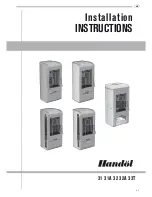
21
GB
The best way to burn your stove
All WANDERS’ stoves are designed so that they give a
maximum output. A well-lit wood-burning stove can
produce a yield of about 75%. This means that you need
less wood for the same amount of heat. Moreover, a
well-lit stove produces less smoke pollution. Below are
a few tips to give you optimum pleasure:
• Always burn your stove with its door closed; this
will improve the output within 8 to 10 times. When
the door of the stove is open, the chimney will draw
more air than is needed for proper combustion. The
relatively cold air will cool the fire. It will also preclude
fire damage by any sputtering sparks, especially from
softwood.
• Do not put more than 3 logs on the fire at one time. Too
much fuel at one time thwarts efficient combustion
and burdens the environment unnecessarily.
• Ventilate the space well when you have the stove on.
A crackling fire has a minimum air consumption of
25 cubic metres an hour. Never put on your cooking
hood when you have a stove burning in the same
space.
• Be careful with lighting the stove when it is foggy
or when there is no wind outside. There is hardly
any draught in the cold chimney when the weather
is calm. Since smoke is heavier than air there is the
chance of smoke streaming into the room. In foggy
weather, the smoke from the chimney (outside) cools
quickly and may descend and become a nuisance in
your neighbourhood.
• Don’t smother the fire suddenly with water, but let it
burn out. The materials inside the stove may deform
or crack as a result of sudden or great differences in
temperature.
• If you want to temper the fire, first close the valve in
the flue tube and then close the air supply.
Chimney and flue
The chimney is the most important part of your wood-
burning hearth.
When the chimney is right it will not distribute any smoke
into your room, leave any deposit on the glass pane or
create bad combustion. Before starting the installation
of the stove, your installer or a qualified chimney sweep
must check whether the chimney flue has a diameter
of at least 150 millimetres over the entire length, and
whether the channel is clean, smooth and leak-proof.
Chimney with a proper draught
Warm air wants to ascend. This is the principle of
every chimney. It helps when the wind near the
chimney mouth draws the air from the chimney.
Fall wind may give the opposite effect and blow
the air back into the chimney. Relatively cold foggy
air may thwart proper draught in your chimney as
does a long flue pipe with a rough inside and many
bends. If the natural draught in your chimney is poor
your installer can give you information about using
a ventilator for your flue tube.
Maintenance
Small maintenance
• It is advisable to leave an ash layer of two to three
centimetres. It will protect the fire plate.
• Clean the exterior of the stove with a damp cloth
that does not give off fluff. Do not use any aggressive
cleansing agents or abrasives.
• Clean the cold glass pane with a cleaning agent for
ceramic cooking rings. Do not touch the clean glass
with your fingers. Finger marks burn into the glass.
• Oil the hinges and the door fastener once in a while.
Do not use any aggressive cleaning agents or abrasives
to maintain your stove.
When the stove is not used
• Close all doors and air inlets in summer season
• Place absorbent salt inside the stove if it is stored in a
humid space.
Yearly maintenance
• Have your chimney properly cleaned by a qualified
chimney sweep every year; this is for safety reasons
and any fire insurance.
• Have the flue gas outlet and the combustion air supply
of the double-walled flue tube system checked for air-
tightness every year.
• Have the complete tube system checked every year;
this includes the roof or wall ducts and the outlet just
outside the wall.
• Have the valves and/or flaps checked for their
functioning.
• Have the sealing of doors and glass panes checked for
wear and tear.
Safety
A WANDERS wood-burning stove gives you a
comfortable and a safe source of heat in your home. Fire
safety starts with a proper installation and a properly
working flue tube. Your installer must therefore comply
with the installation instructions as listed on page 23 and
further. To burn your stove safely, the following points
are important:
1. Burn your stove as much as possible with a closed
door; it increases the output and is better for the
environment.
2. Prevent small children or the infirm from getting too
close to a burning stove and do not leave them alone
in the room when the stove is burning. You could use















































